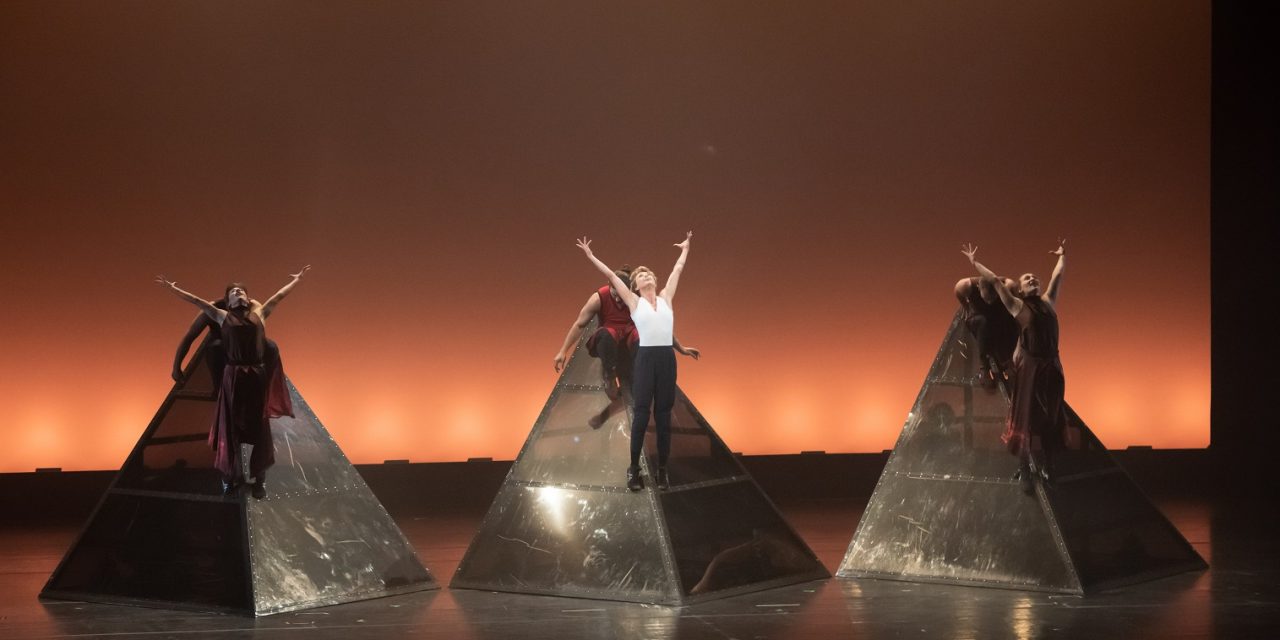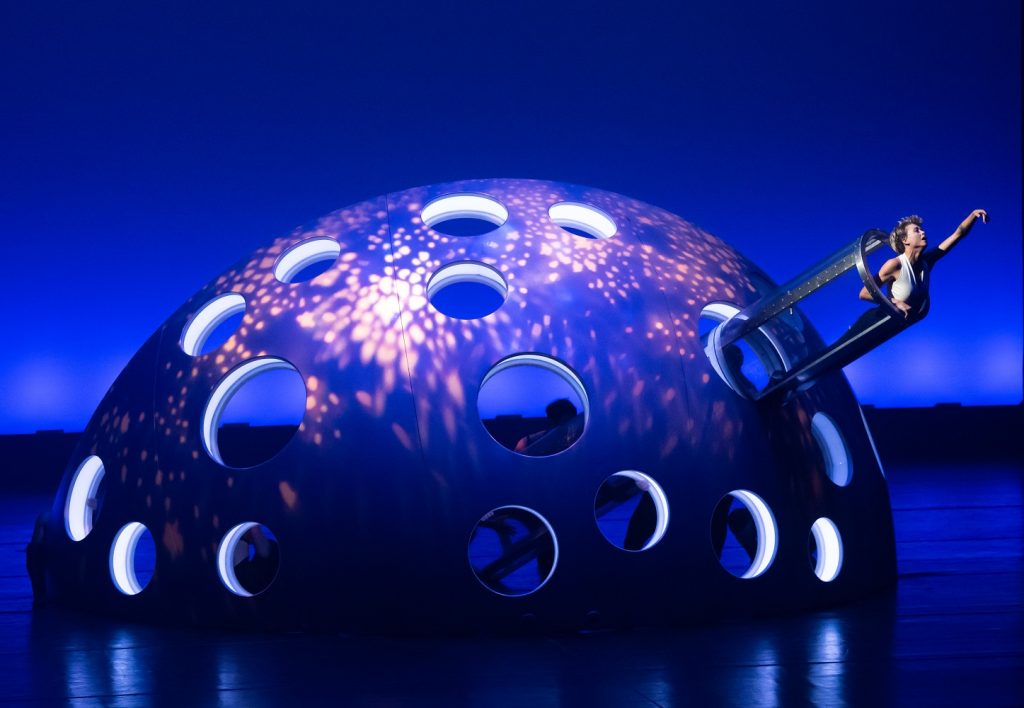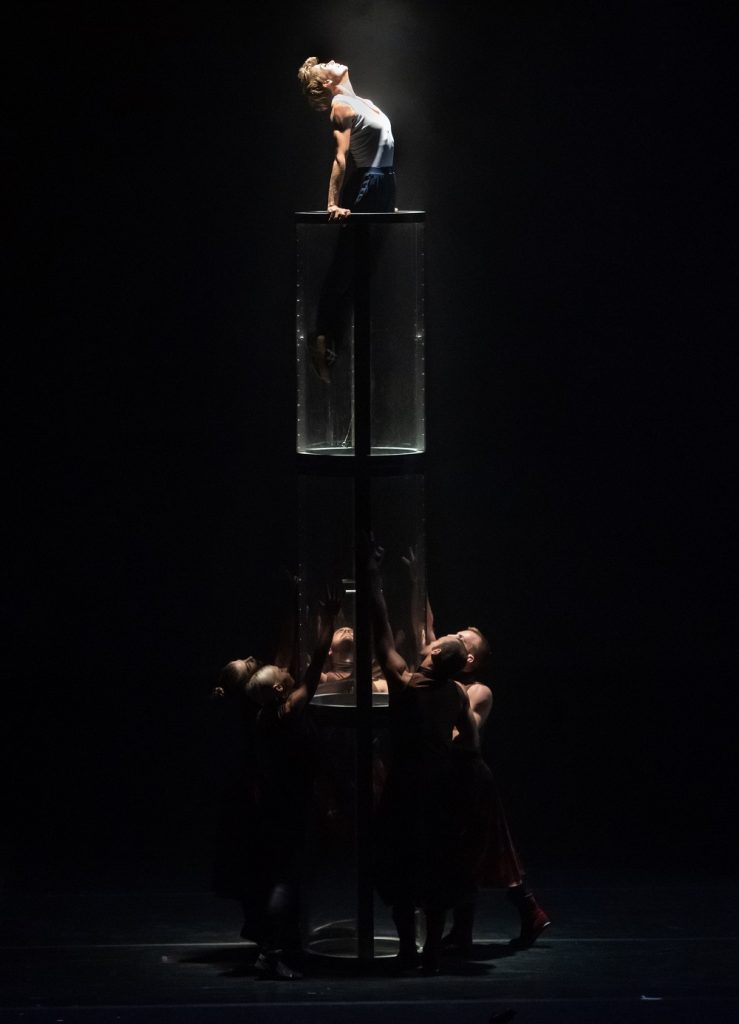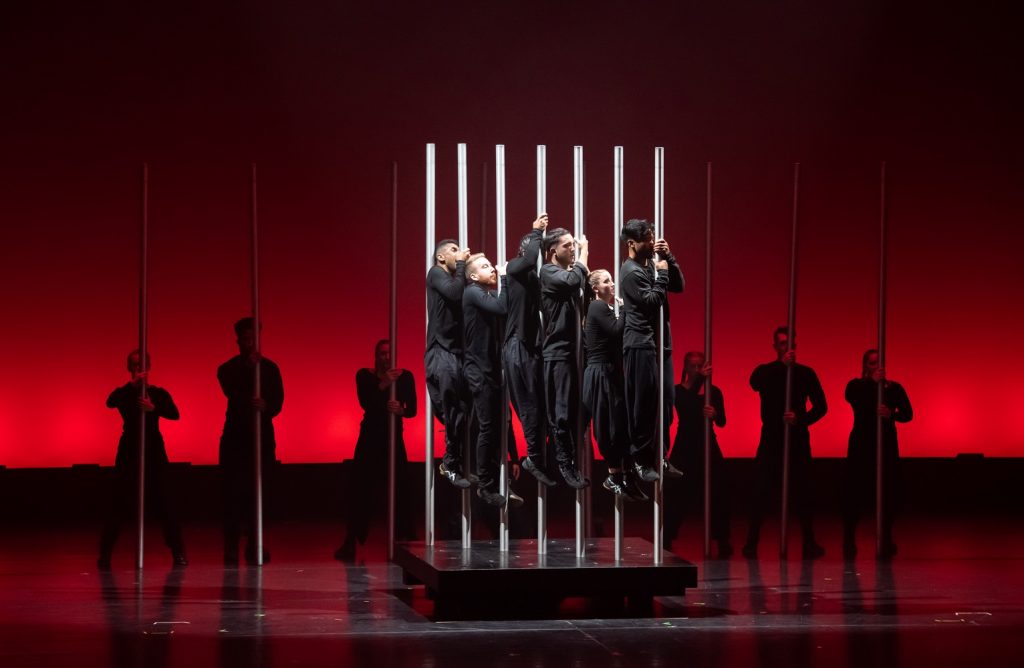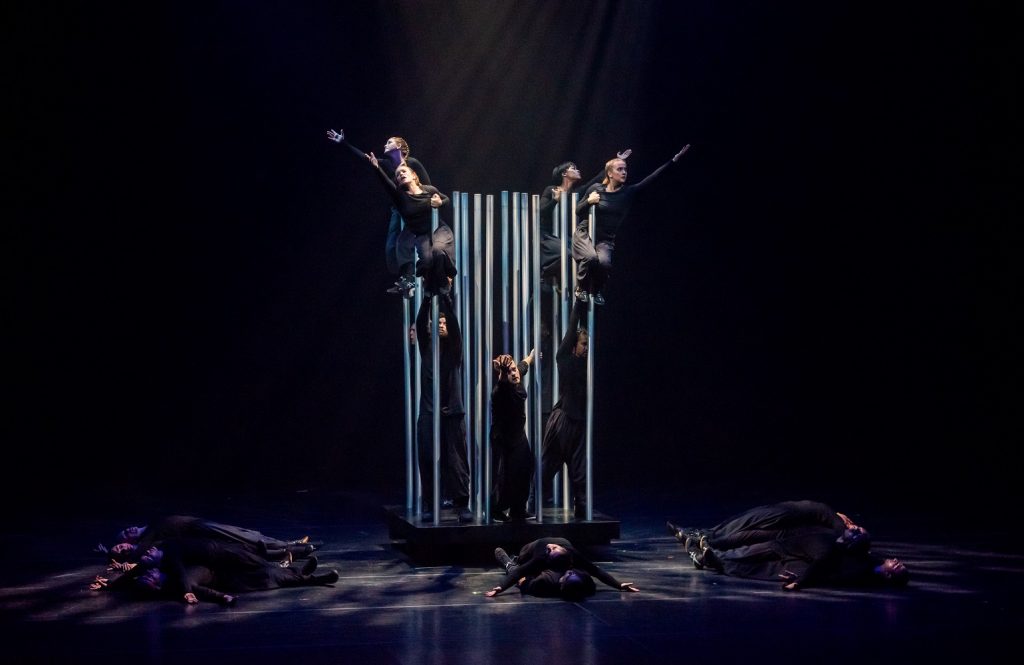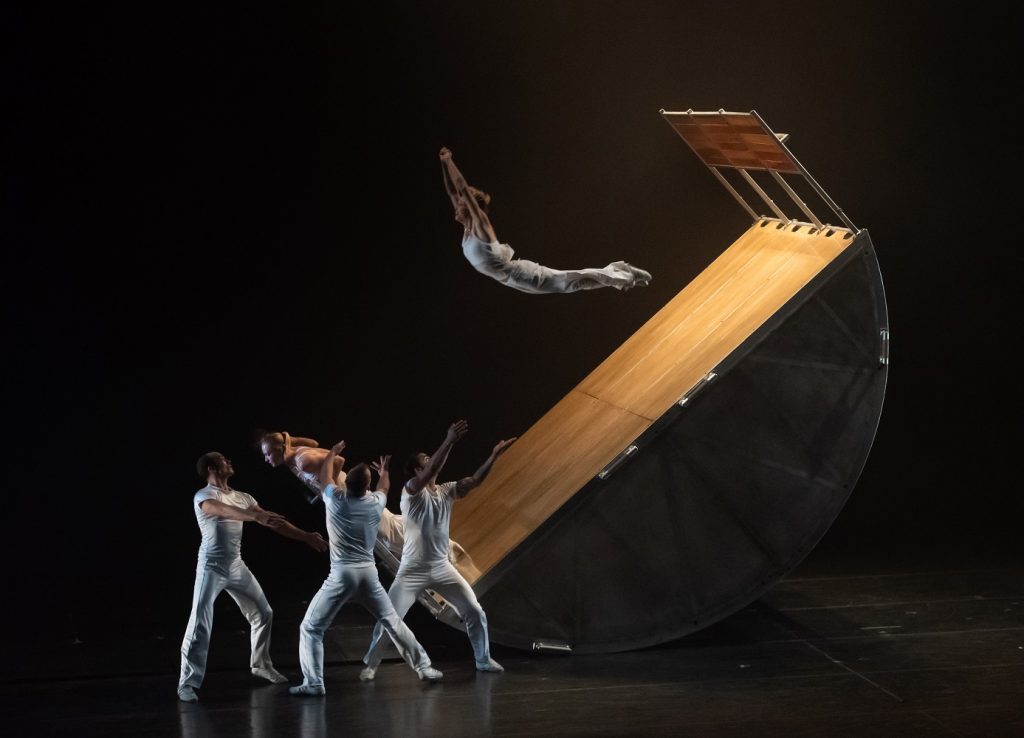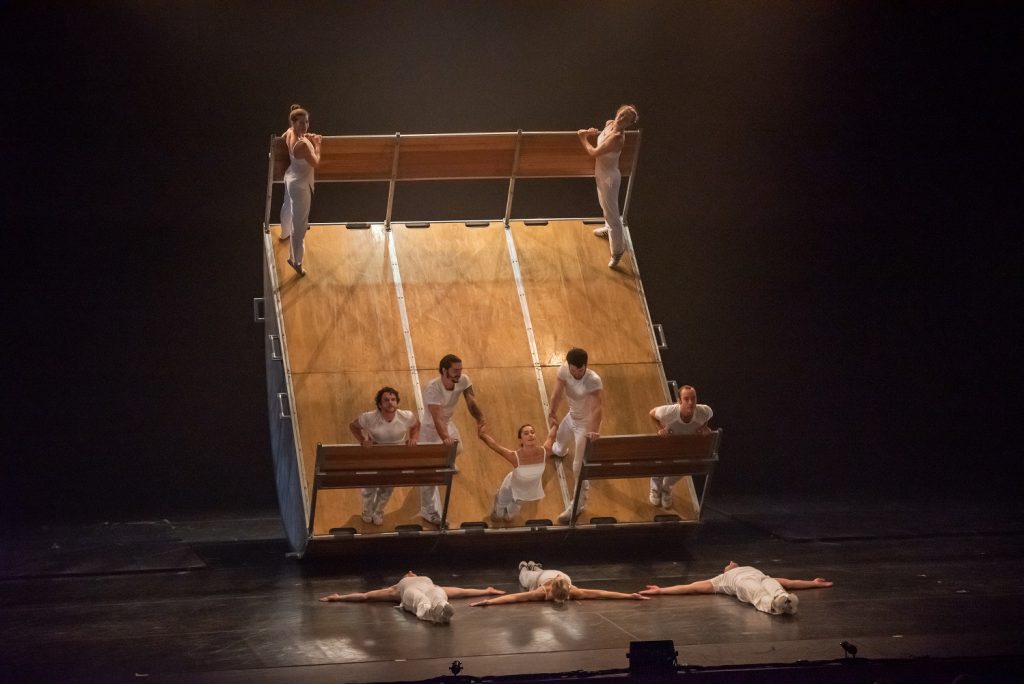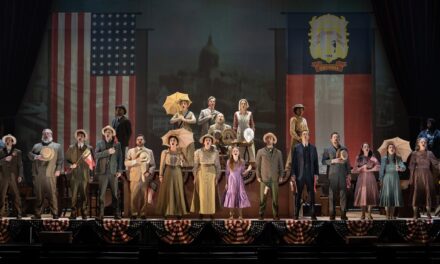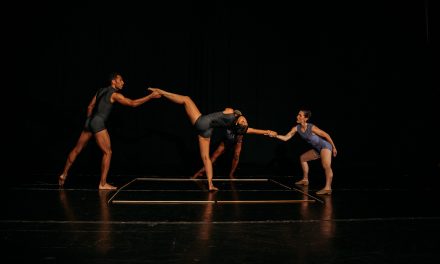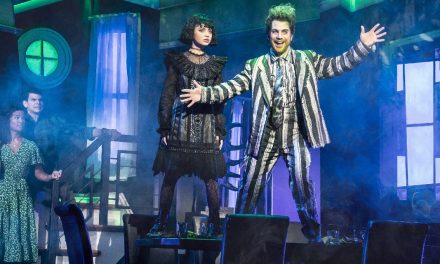“DIAVOLO Architecture In Motion” wowed a sold-out crowd at the Musco Center For The Arts, at Chapman University in the charming city of Orange, this past weekend. A quote from the program refers to DIAVOLO as “a new art form,” and I would agree. This hybrid of movement and apparatus is unlike anything you will see anywhere. Founder and Artistic Director Jacques Heim has imagined and brought to life a world unto itself.
Up first was “Voyage” a tribute to the 50th Anniversary of the first moon landing. The voices of the original astronauts accompanies the spacey soundscape by Simon Greenberg with music by ODESZA, Zach Hemsey, Moby, The Crystal Method, Sarah Jaffe, Florence and The Machine, and John Hopkins, seamlessly edited to create one cohesive piece. A voiceover written by Saffron Douglas and spoken by Stephanie Niznik gets lost in the shuffle. The adequate costumes design is by Brandon Grimm.
The curtain rises revealing a large half dome covered in holes looking, not surprisingly, like the Swiss cheese moon. Smoke pours through the holes and all is bathed in blue light. It moves offstage and is replaced by a framed doorway where we find stunningly agile lead dancer Kelsey Long alone in contemplation. Her need to move through the door is thwarted by several dancers who hold her back with nimble choreography. A large plexi-glass tube symbolizing a rocket is brought onstage as the doorway moves off and she climbs in. We understand that she has pushed past the door and into the outer space of her imagination. Here the remaining company of twelve top-notch dancers, acrobats, daredevils and all around elite athletes, join her. They are, Bethany Rose Boutwell, Christopher Carvalho, Kate Dougherty, Daniel Jacob Glenn, Simon Greenberg, Anna-Marie Knutson, Aubrey Lawrence, Majella Loughran, Ezra Masse-Mahar, Abraham Meisel, Lex Shimko and Matthew Wagner.
In an alternate universe, a flat black platform glimmers in the light and magically transforms into a multitude of shapes, triangular structures, pyramids, walls etc., each one more intriguing than the next and all with usable performance areas. The dancers leap, roll, climb, fall, flip and dance on every surface with breathtaking speed and agility. It’s impossible to describe just what DIAVOLO achieves with these large abstract constructs. Under the direction of Jacques Heim and with the choreographic input of the dancers, who receive credit, an exploding world of magical realism is created. Gorgeous lighting by Evan Merryman Ritter and John E.D. Bass draws you into this spacey realm.
Within the continuous flow of movement, a thin story line evolves as lead dancer Long finds romance in fiery Simon Greenberg. Though the intent was there, chemistry was lacking between these two. Perhaps slowing things down and putting the focus on the couple for a moment of seduction would benefit the story line and allow the audience to take a breath and feel their attraction.
As the ensemble and gleaming black shapes disappear a new shape appears. This is one section of a structure that will eventually intertwine with three more pieces to create a huge hollow wheel. A solo female dancer begins this segment using the prop in every conceivable way until the full company joins her and the wheel is complete. The choreography and staging throughout is exceedingly difficult and very clever.
The return to earth and everyday life is just around the corner as the Swiss cheese moon replaces the stunning wheel, this time with the rocket tube protruding through a hole that will blast our soloist home. It’s a wild, exciting ride but the next time we see her she is alone again at the doorframe.
In an effort to bring cohesion to the slight story the two leads meet again on earth through the doorway as ordinary people. Though the choreography is as inventive as always, again we are missing any real connection between the pair and this leaves the audience slightly let down. A lover’s adagio both here and earlier in the piece would be welcome. Still, it’s a lovely picture when the couple climbs to the top of the doorframe and you can sense that they are caught between two worlds as the lights go to black.
“IBUKI” comes from the “The Veterans Project” a six-week intensive workshop, which culminates in a performance. The purpose is to use “movement as medicine to help heal and connect our American heroes.”
Seven veterans join thirteen DIAVOLO performers for this work. Creating a piece that moves at break-neck speed is not easy and when many of the performers within it, have no training in stage movement it’s a feat that can backfire. But in the capable hands of Diavolo this does not happen. Everyone lives up to what is expected with this mostly successful work.
The sounds of war fill the theater creating a sense of foreboding, as the lights illuminate the 20 performers lining the front of the stage. Each one steps forward in a military roll call and shouts their name as our intro to a harrowing night yet to come. Intricately designed and intensely staged, Heim and the company create one stunning tableau after another. It is a dark and dangerous place they inhabit and for the duration you are there too. As the piece develops 14 tall white poles are added as symbolic weapons. Much is made of them as they sweep the stage mowing down everyone in their path. By placing the poles into a center platform a prison is formed and make no mistake, no one escapes. This is an anti-war piece without apology. Yet, “Ibuki,” a Japanese word meaning “inner strength, renewal, resilient enough to endure and emerge beautiful” stands true.
Though the work is powerful it begins to lose its force as it becomes somewhat repetitious and too long. A few judicious cuts would make all the difference.
There is a spoken word aspect to this endeavor that gets lost against the intense action onstage. As well as being hard to hear it feels superfluous. Also superfluous is “The Spirit of the Fallen” or man in white, Kelly Edwards. He was given a central role although; he is uncomfortable with stage movement and seems out of place. He was however, a superior reader of the spoken word and might have been better as the speaker throughout.
Again expert lighting by Evan Ritter and impressive soundscape and powerful music by Robert Allaire perfectly support the stage action.
As successful as the work is, it unfortunately was followed by a misplaced Q&A. This only served to bring down the momentum of the night. Perhaps moving this to the end of the evening would have been a better choice.
It’s important to note that this is a worthy project that brings a critical message to the public about the care and attention that our Veterans deserve. DIAVOLO is to be commended not only is the work meaningful but is also artistically satisfying. “The Battalion” of performers are (note; the veterans were not singled out in the program) Arthur Aleksanyan, Bryn Christofferson, Michah Coate, Andrew Corpuz, Ayla Decaire, Steven Eatmon, Caleb Fields, Caribay Franke, LaShaunda Johnson, Karil Jo List, Ejay Menchavez, Alex Mendy, Aleksandra Nalepa, Elijah J Salvatore, Madison Sha, Ivan Sharudo, Justin Stirewall and Evan Turner.
The final piece of the night was “Trajectoire”. The program states that this is about “the struggle to find balance on a voyage of destiny and destination.” This description is fulfilled by the remarkable, rocking Ark like structure that dominates the stage. A lone female dancer, Aubrey Lawrence, begins what will become an iconic work of beauty. Soon other female dancers join her and together they defy gravity with acrobatic lyricism atop the rocking ship. Ultimately the full company works the structure in a dazzling display of innovation and creativity.
Sheer bravado is the term that comes to mind when describing the members of this company. Intense focus and committed teamwork are imperative as split second timing can mean the difference between perfection or disaster. Remarkable feats of daring were perfectly executed and kept the audience on the edge of their seats
The all white costumes, by Megan Godfrey, make for a lovely contrast to the dazzling golden structure of the Ark. Original lighting is credited to Daniel Lonazzi, with lighting design by John E.D. Bass.
Perfectly underscoring the action on stage and enveloping the audience with its cadence and beauty, is the music composed by Nathan Wang.
“Trajectoire” most fully captures the essence of DIAVOLO and the vision of Jacques Heim and his exceptional team of artists.
Additional credits include;
“VOYAGE”: Structure Design, Mike McCluskey, Tina Trefethen, Adam Davis, Jeremy Railton; Structure Engineering and Construction, Mike McCluskey LTD., Tina Trefethen
“IBUKI”: Structure Designer, Sculptor, Daniel Wheeler; Structure Engineering Concept and Design, Mike McCluskey, Tina Trefethen
“TRAJECTOIRE”: Structure Design, Daniel Wheeler; Engineering, Dan Williams; Structure Construction, Mike McCluskey LTD., Daniel Wheeler
Written by Tam Warner for LA Dance Chronicle, September 28, 2019.
To visit the Diavolo: Architecture In Motion website, click here.
To visit the Musco Center For The Arts website, click here.
Featured image:

